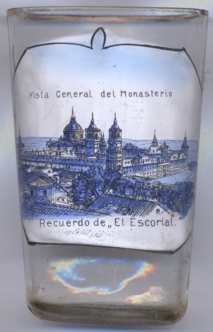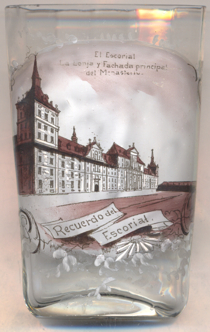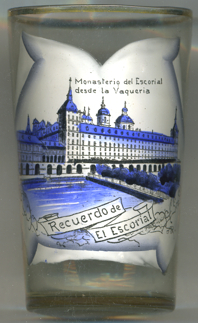

|
| ESPAÑA | Spain |
| Comunidad de Madrid |
 San Lorenzo de El Escorial is situated at an elevation of 1,032 m on the southern slopes of the Mount Abantos
in the nothwest of the Comunidad de Madrid region about 47 km northwest of Madrid. The settlement is popularly called
El Escorial de Arriba, to differentiate it from the neighbouring village of El Escorial, also known as
El Escorial de Abajo. The municipality of San Lorenzo de El Escorial has a population of about
18,200 (2015).
San Lorenzo de El Escorial is situated at an elevation of 1,032 m on the southern slopes of the Mount Abantos
in the nothwest of the Comunidad de Madrid region about 47 km northwest of Madrid. The settlement is popularly called
El Escorial de Arriba, to differentiate it from the neighbouring village of El Escorial, also known as
El Escorial de Abajo. The municipality of San Lorenzo de El Escorial has a population of about
18,200 (2015).
The history of San Lorenzo de El Escorial is inexorably linked to the construction of the monastery and the town named El Escorial. The construction of houses, expressly prohibited in the outskirts of the monastery, was the cause of a dispute that faced the municipal authorities, who promoted a modification of the rules, and those who sought to restrict new construction. The subject was particularly delicate in those days, given the frequent visits of the Royal family to the site; these visits led to an increase in demand for land to build houses and support buildings mainly for civil servants working in the Royal household. The resolution of the conflict came from King Carlos III, who, on 3 May 1767, authorized housing next to the market of the monastery, which was the birth of the municipality of San Lorenzo de El Escorial and the beginning of a process which culminated in the emancipation of the town from El Escorial. In 1836, San Lorenzo de El Escorial became an independent municipality.

 The
The  Monastery of San Lorenzo de El Escorial [left]
is one of the Spanish royal sites (‘reales sitios’) and functions as a monastery, royal palace, museum, and school.
About 5 km abway, La Granjilla de La Fresneda, a royal hunting lodge and monastic retreat, also belongs to the El Escorial.
During the 16th and 17th centuries, the sites were places in which both the power of the Spanish monarchy and the ecclesiastical
predominance of the Roman Catholic religion in Spain found a common architectural manifestation.
Philip (Felipe) II of Spain engaged the Spanish architect, Juan Bautista de Toledo, to be his collaborator in the design of
El Escorial. Juan Bautista had spent the greater part of his career in Rome,
where he had worked on the basilica of
Monastery of San Lorenzo de El Escorial [left]
is one of the Spanish royal sites (‘reales sitios’) and functions as a monastery, royal palace, museum, and school.
About 5 km abway, La Granjilla de La Fresneda, a royal hunting lodge and monastic retreat, also belongs to the El Escorial.
During the 16th and 17th centuries, the sites were places in which both the power of the Spanish monarchy and the ecclesiastical
predominance of the Roman Catholic religion in Spain found a common architectural manifestation.
Philip (Felipe) II of Spain engaged the Spanish architect, Juan Bautista de Toledo, to be his collaborator in the design of
El Escorial. Juan Bautista had spent the greater part of his career in Rome,
where he had worked on the basilica of
El Escorial has been the burial site for most of the Spanish kings of the last five centuries, Habsburgs as well as Bourbons.
The Royal Pantheon contains the tombs of Holy Roman Emperor Karl (Charles) V (
The monastery and its historic surroundings were declared a
UNESCO World Heritage Site in 1984,
under the name of “El Escorial, monastery and site”.
[https://de.wikipedia.org/wiki/San_Lorenzo_de_El_Escorial, https://en.wikipedia.org/wiki/San_Lorenzo_de_El_Escorial;
https://en.wikipedia.org/wiki/El_Escorial]
![[scale]](lineal.jpg)